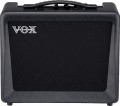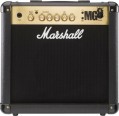Type
The type of device is determined by the element base — the main type of parts on which the power amplifier circuits are built. Accordingly, this parameter is relevant only for equipment with such amplifiers; for cabinets (see "Type") it is not indicated.
The most popular nowadays continue to use traditional types of amplifiers —
transistor and
tube.
Digital models are noticeably less popular, and
hybrid solutions are rare at all. Here is a detailed description of each of these options:
— Transistor. Amplifiers of this type are relatively simple and inexpensive, while being able to provide quite acceptable sound quality (although, of course, everything depends on the class). It is the “transitor” that is recommended for beginner guitarists as the first “combo”, although there are quite advanced models among such devices. Of the unequivocal advantages of transistor circuits, one can name the durability of the components and the ability to easily transfer frequent carrying from place to place. As for the sound, in such devices it turns out to be more “dry”, “flat” and “cold” than in tube models, which many consider to be a clear disadvantage. At the same time, in the case of electric guitars, even this is quite enough for initial training, rehearsals and not very “fancy” performances; in addition, some transistor ampl
...ifiers use specific signal processing to give the sound a tube-like sound. And combo amplifiers for acoustic guitars are overwhelmingly made with transistors.
— Lamp. Historically, the first type of amplifier, which, nevertheless, is still considered almost the standard when it comes to electric guitar (tube circuits are practically not used for acoustic guitars). The main advantage of such devices is the notorious “warm tube sound”, a characteristic soft, warm and at the same time rich coloring of the sound. At the same time, we note that the level of distortion in tube circuits is higher than in transistor circuits, however, these distortions are more pleasant to the ear, in many respects they provide the mentioned coloring. The widespread use of tube amplifiers is hindered primarily by their high cost — several times higher than that of transistor amplifiers with similar characteristics. In addition, among the disadvantages of such devices, it is worth noting the delicacy (the lamps do not tolerate shocks and shocks), the rapid wear of the lamps and the need for their regular replacement, as well as the need for warming up after switching on. However, professional musicians prefer to use mainly tube devices.
— Digital. Chip-based amplifiers using digital audio processing. The main advantage of such devices is the extensive possibilities for modeling sound and providing various effects. In particular, there are many models that copy tube amplifiers: the imitation is very reliable, and sometimes almost indistinguishable from the original. At the same time, digital models are devoid of many of the shortcomings of lamp technology: they are simpler, cheaper, more durable and more resistant to shock and shock. At the same time, digital processing is considered to take away personality from the sound, and many high-end audio enthusiasts are suspicious of digital solutions.
— Hybrid. Hybrid devices are devices that combine transistor and lamp circuits; usually a preamplifier is made with a tube, and a power amplifier is made with a transistor. In fact, this is a compromise between purely tube and purely transistor models, which allows you to combine the advantages and partially compensate for the shortcomings. Thus, hybrid solutions are noticeably cheaper than lamp solutions, they are lighter, more compact, less delicate and have fewer lamps that require regular replacement. And the sound at the same time turns out to be softer, cleaner and “warmer” than that of transistor analogs. At the same time, not many musicians choose such a compromise: those who strive for the highest quality and reliable sound prefer to spend money on tube equipment, and undemanding users (such as amateurs and beginner guitarists) are quite satisfied with transistor models. Therefore, there are relatively few hybrid models on the market.Impedance
The impedance of the speaker(s) installed in the amplifier.
Impedance is the resistance to alternating current — that is, the current flowing when an audio signal is applied. This impedance affects the compatibility of the speaker with the power amplifier: if the impedance is too low, sound distortion occurs, if the impedance is too high, the volume is reduced. However, in combo amplifiers, this parameter is most often given as a purely reference: such devices have their own power amplifier, which, by definition, is designed for the impedance of the “native” speaker, and separately, with extraneous components, the speaker and amplifier are not used.
Woofer size (LF/MF)
The diameter of the woofer or woofer installed in the combo amplifier. The specific value of this parameter may be different, depending on the number of lanes (see above). In three-way systems we are talking about bass dynamics, in two-way systems — about the dynamics responsible for low and medium frequencies; and if the amplifier does not have band separation, this paragraph indicates the diameter of the main radiator.
In general, the larger the radiator, the louder it can sound and the richer the bass from such a speaker is. At the same time, we note that the speaker diameter is selected by the manufacturer based on the power of the built-in amplifier and the expected sound volume. So the main indicator when choosing is still the rated power, and the size of the speaker is more of a reference value.
Analogue simulation
The presence of an analogue modeling function in the amplifier.
The meaning of this function lies in the fact that with the help of analogue sound processing, the amplifier changes the sound in a certain way, giving it one colour or another. So, many models provide modeling the sound of certain classical guitar amplifiers and/or cabinets; of course, there is no question of absolute similarity, but sometimes a copy can be almost indistinguishable from the original. Other models built on transistors (see "Type") can copy the sound of tube technology. And the analogue method of sound processing for such modeling was chosen because it allows you to do without unnecessary conversions (unlike digital); this has a positive effect both on the quality and atmosphere of the sound, and on the price and reliability of the equipment.
The specific features of analogue modeling in each case should be clarified separately, however, anyway, it significantly expands the functionality of the amplifier and provides additional features for fine-tuning the sound.
Digital effects block
The presence of a block of digital effects in the amplifier. Note that this function can be provided in any models, not only digital ones (see "Type").
As the name implies, this function allows you to change the sound in one way or another, sometimes quite drastically. See below for the most popular effects; their specific set may be different, it should be specified separately in each model. Here we note that without this function, additional external “gadgets” will be required to work with effects.
Gain
The presence in the amplifier of the regulator "Gain".
This control is responsible for adjusting the intensity of overdrive when using effects such as distortion or overdrive. Thanks to him, you can change the severity of these effects — from almost complete absence to pronounced distortion, which has little to do with a clean guitar sound.
Effects
Built-in effects provided in the combo amplifier. You can also achieve various effects with the help of external “gadgets”, however, such gadgets need to be searched for and connected separately, while built-in effects are available immediately and without unnecessary settings.
—
Overdrive. Distortion in the form of a characteristic electric guitar "buzz" at low frequencies and "howl" at high frequencies, a little softer than distortion. Popular, in particular, in hard rock.
—
Distortion. Sufficiently hard and sharp distortion, similar in sound to overdrive, but more intense and brighter. It is widely used in various styles of metal, and is also found in rock.
—
Reverb. An effect based on simulating multiple decaying echoes from each sound. Depending on the duration and intensity of repetitions, it can give the sound a different colour. Used as an artistic device; among other things, it can create the effect that the guitar sounds in a certain room (concert hall, room with stone walls, an open area in the mountains, etc.). Note that the reverberation can be adjusted both by individual parameters (intensity, echo duration, etc.), and by selecting a preset set of parameters (for example, “sharp sound in the room” or “soft sound in the hall”).
—
Tremolo. Tremolo is basically a trembling effect that res
...ults from small and quick fluctuations in the volume of each note. Sometimes this term means vibrato (see below) — to the point that the manufacturers of guitar amplifiers themselves mean the effect of vibrato by the tremolo effect, and vice versa. So the specifics of this effect in each case should be clarified separately. Anyway, the tremolo can be "fixed" or adjustable in depth (range of volume change) and speed (jitter frequency).
— Vibrato. Another effect of "jerking" sound, which is often confused with tremolo (see above) — to the point that both these terms are used as identical. However, this is not true; the difference lies in the fact that vibrato is carried out due to the rapid fluctuations of the note not in volume, but in frequency. A similar effect can be achieved on the guitar itself by "pulsating" the strings, but using the amplifier's built-in instrument is much more convenient in most cases.
— Chorus. An effect designed to simulate the choral sound of an instrument. To do this, the amplifier copies the sound of the guitar and plays several copies simultaneously with the original signal, slightly shifting them in time (about 20 – 30 ms with a constant change) and frequency. However it is impossible to achieve a full-fledged choral sound in this way, but the effect is quite original in itself.
— Delay. A specific type of reverb (see "Reverb") that has become widespread as a separate effect. Delay simulates a clear single echo from the sound being played; for this, the original signal is copied and reproduced with a certain time delay (at least 50 ms).
In addition to those described above, other effects can be found in modern guitar combo amplifiers, in particular:
— Flanger. The effect is reminiscent of the whistle of a jet engine; it is often compared to a plane taking off. It is created similarly to the Chorus described above, differs from it in a shorter delay time and the presence of feedback.
— echo. Another kind of reverb, similar to delay (see “Delay”). It differs in that in this case the echo is reproduced repeatedly.
— Octaver. An effect in which a copy of it is added to the signal, shifted by an octave or two.
— Wah wah. An effect that produces a characteristic "croak" sound.
